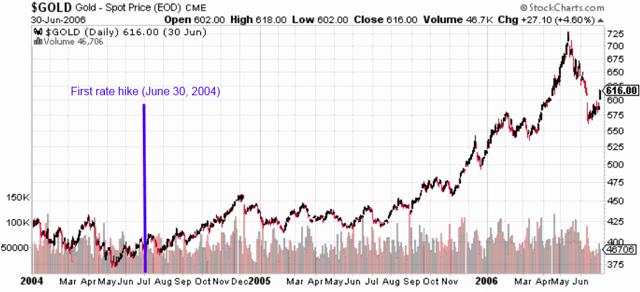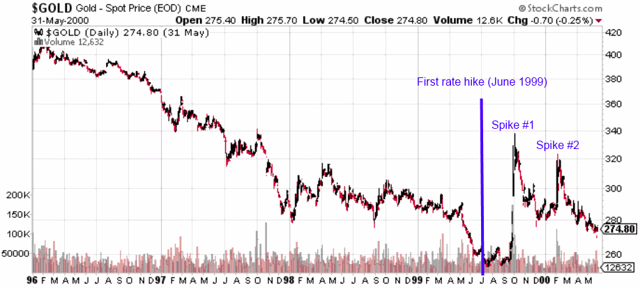Buy Gold When The Fed Raises Rates
Jul. 15, 2015 2:20 AM ET
.
Summary
- Odds are good that the Fed will start raising rates in December.
- The anticipation of higher rates is hurting gold.
- Historically, buying gold at the beginning of a Fed rate raising cycle has been profitable.
The conventional wisdom is that gold (NYSEARCA:GLD) falls when interest rates are high. This is based on the idea that because gold doesn't pay any interest or dividends, investors will not want to buy it because they can park their money in bonds and receive high interest rates instead. However, gold has performed rather well during the last two periods of Fed rate hikes.
The last period in which the Fed raised rates was from June 2004 to June 2006. During that time, gold rose from under $400 to over $700. The first rate hike occurred on June 30, 2004. In the six months prior to the first rate hike, gold fell from roughly $430 to $375. You can see this in the chart below.
(click to enlarge)

Prior to 2004-2006, the next most recent period of rate hikes was from June 1999 to May 2000.
You can see in the chart that gold spiked up twice during that period. Gold ended up with only a modest gain during that 11-month rate raising period, but prior to the first rate hike in June, gold was in a 3-year bear market. From January 1996 to June 1999, gold fell from over $400 to roughly $260.
(click to enlarge)

These two historical examples show that a good time to buy gold is right after the first rate hike. In the first example, it was actually better to buy it before the first rate hike, but that would've required accurately guessing at which meeting the Fed would've raise rates for the first time, so buying it after eliminates that risk.
After a disastrous 2013 and a slightly down 2014, gold is once again having another slightly down year this year. I believe this is in part due to the anticipation of the Fed raising rates this year. At the beginning of the year, the consensus was that the Fed would hike rates in June.
Then it got pushed back to the September meeting. Now the consensus view is that December will be the first rate hike.
According to Reuters, traders see a 66% chance that the Fed will raise rates in December. I think the anticipation of the rate hike and the fact that it keeps getting pushed back is one of the major factors that is hurting gold this year. It would be better for gold if the Fed just raised rates right now and got it over with. The lyrics from a 1971 song by Carly Simon called Anticipation sums up my feelings on gold.
Anticipation, Anticipation
Is making me late
Is keeping me waiting
If the Fed does indeed meet expectations and raises rates by a quarter point in December, I believe there is a decent possibility that could mark the end of gold's four year bear market.
Gold peaked in August 2011 at almost exactly $1900. In the mean-time the anticipation of the first hike will likely keep the price down. Some pundits and analysts have made predictions of gold reaching lower lows this year.
- Morgan Stanley - $1138
- Commerzbank - $1100 (a possibility)
- Goldman Sachs - $1050 (end of 2015)
- Peter Brandt - $1050
- Avi Gilburt - GLD $98 (equivalent to ~$1022 gold)
- Louise Yamada - $1000
- ABN Amro - $1000 (end of 2015)
- Harry Dent - $700
That price would match the 47% decline during gold's bear market from 1974 to 1976. By the way, gold went on from that point to rise 8x from roughly $105 to nearly $860 in less than four years. The second one is $1077 (~$103 GLD).
That would be a 50% retrace of gold's entire bull market from July 1999 to August 2011. Both targets look reasonable considering what others have predicted.

0 comments:
Publicar un comentario